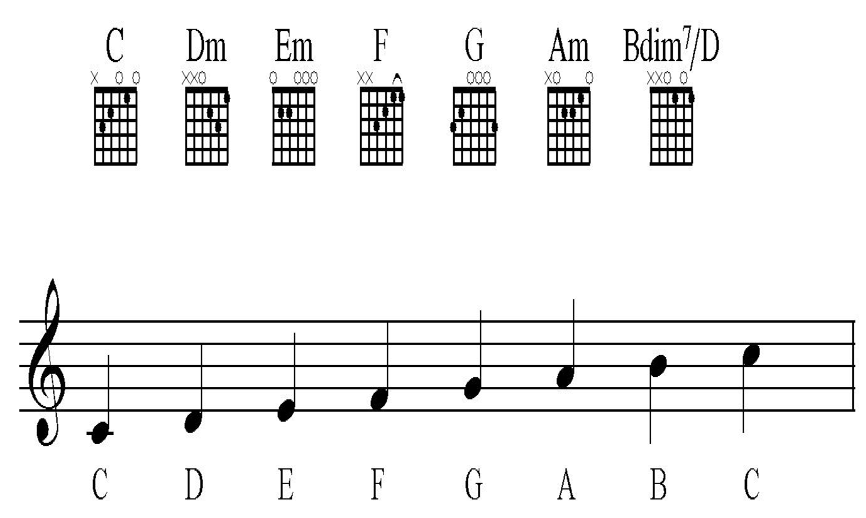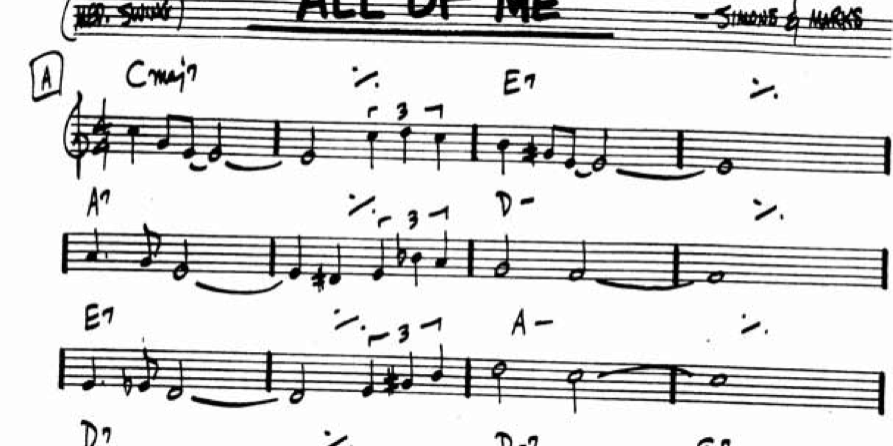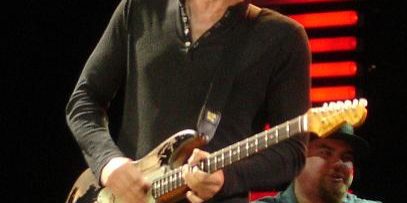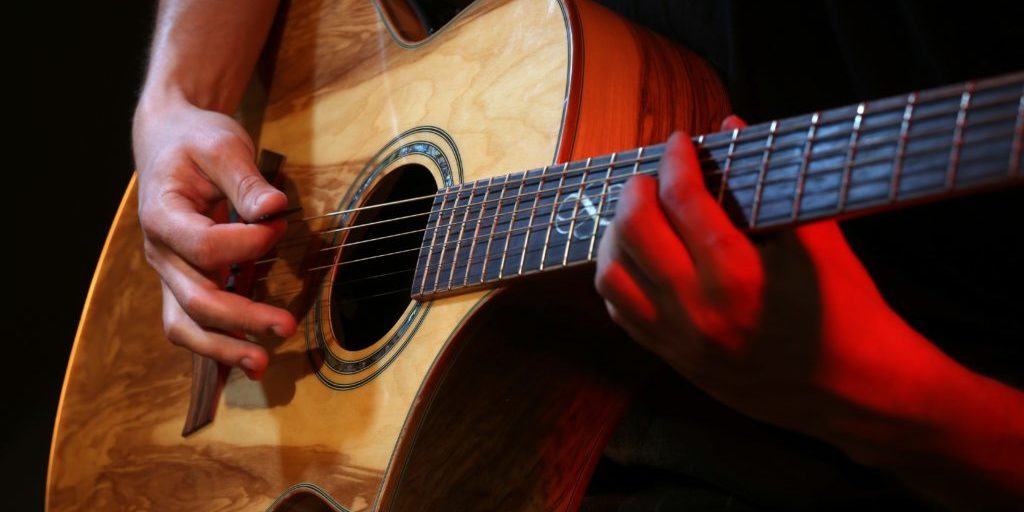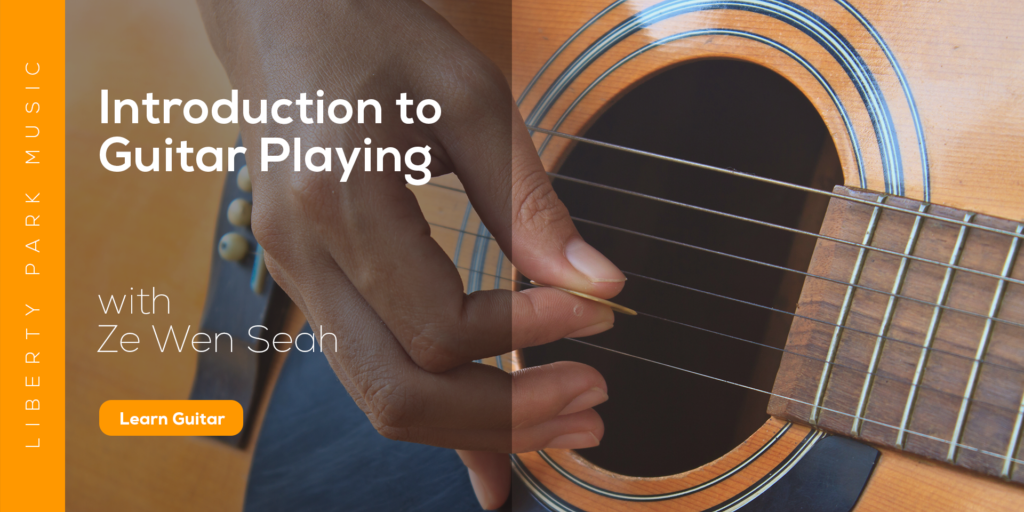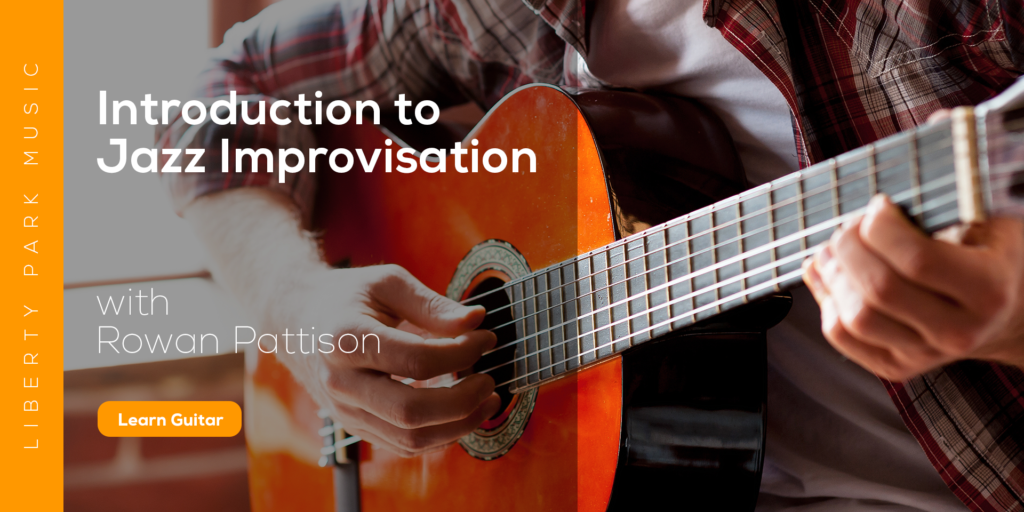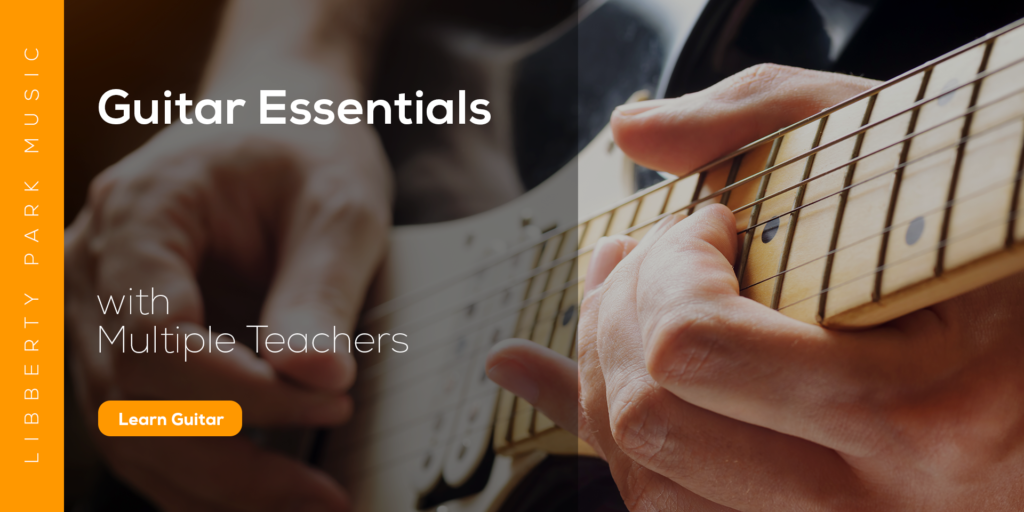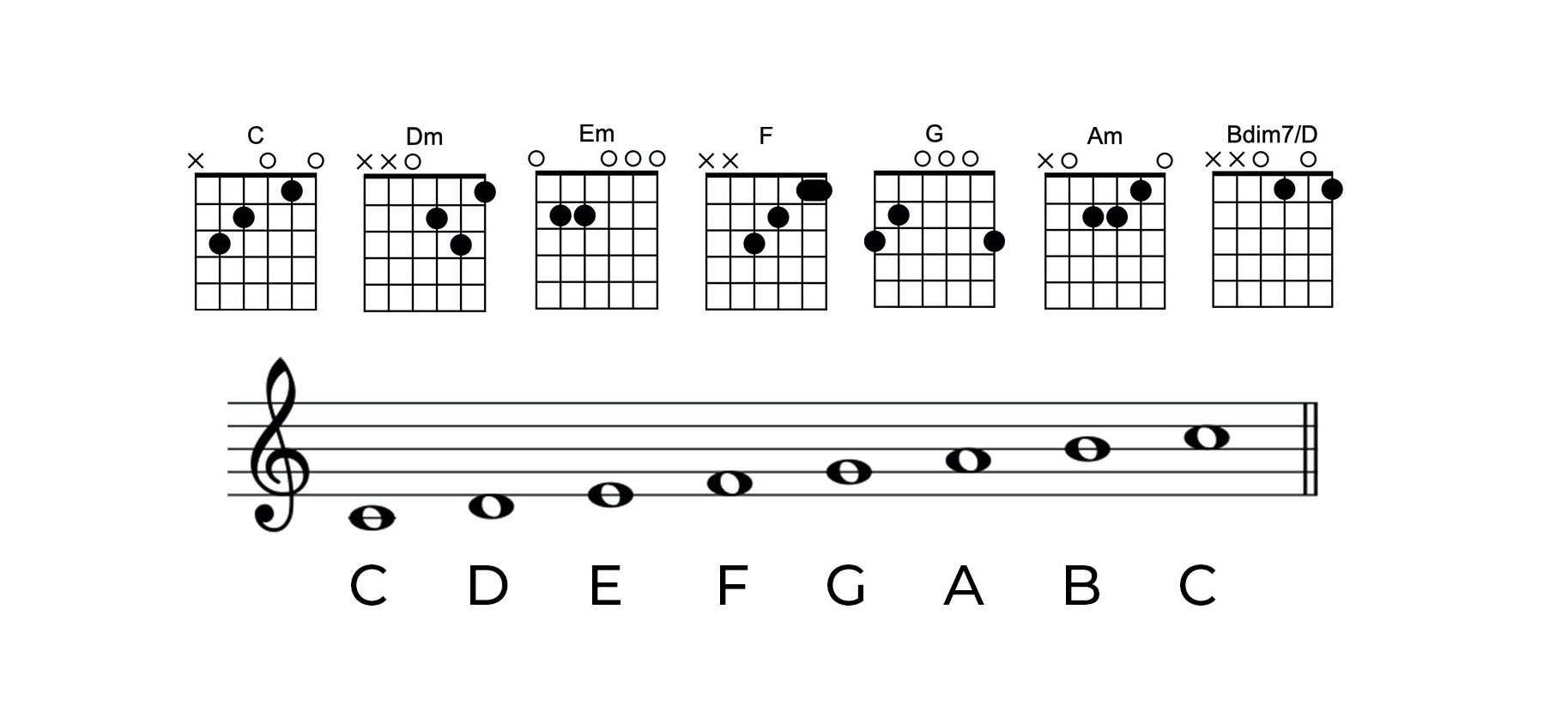
We hear music in keys. Each piece of Western music can be transposed into 12 different keys, so it makes sense to learn each key centre thoroughly.
C major is the simplest as it contains no sharps or flats. In relation to the piano, this scale is played on white keys only, which makes the scale visually more approachable.
C major on the guitar is not always the first scale we learn, some often learn G or D. But if we are to approach the guitar in a theoretical way, it really is best to start with C major.
In addition to having no sharps or flats to think about, it also contains all the open notes of a guitar, so we can use this to our advantage.
The key of C contains 7 notes: C, D, E, F, G, A, B; we can mix up these notes to play melodies.
If all of the your favorite pop songs were played in the key of C major, chances are they only use these 7 notes, whether it is in the melody, the chords, or the bassline. The intervals between these notes work together to create a key. If I were to play a note outside the key, say a G#, it would be called non-diatonic--meaning that the note is not diatonic, or does not belong, to the key of C major.
Some of you may be reading this article as part of our Guitar Solo Style Course. In this course, we are only going to be playing diatonic arrangements, this means that all the notes we will use will be either C, D, E, F, G, A, or B. Everything will also be played in open position which refers to the first 3 frets, so it is vital that we have an understanding of our chords and scale in this position.
C Major Scale
A major scale is made up of a pattern of intervals, steps and half steps (also called tones and semitones outside the U.S.). If we are to play each note available to us on any Western instrument in an ascending or descending order, then each note will be one half step away from the next.
Thus, when ascending from C in half steps, we get C, C#, D, D#, E, F, F#, G, G#, A, A#, B, and back to C. Notice how there is no sharp in between E - F and B -C, The ascending series of these notes is a chromatic scale. A whole step is made up of two half steps.
To make a major scale, we don’t ascend with just half steps, but with a pattern of whole steps and half steps. For a C major scale, we would play all the natural notes: C D E F G A B C. The step pattern of a major scale goes:
Step - Step - Half Step - Step - Step - Step - Half Step
Whatever note I start the pattern on will give me a key. For example, if I start on G, and ascend in the pattern of whole steps and half steps, then I will get the G major scale and all the notes in the key of G major. We are doing C major, so we will start on C which will look like this:

Notice there is a half step between E and F and a half step between B and C, this is what gives us the melodic characteristics of a scale.
We are going to play the C major scale entirely in first position starting on the open E string. The C (start of the scale) is on the third fret of the A string (in Red), but we are going to start down as low as possible for the sake of covering all the notes in C major in the first position.
The red notes mark ‘C,’ this is where the step/half step pattern is referenced from.
The bottom of this diagram represents the low notes of the guitar up to the top which represents the high notes.
Any dots that are off the diagram to the left represent the open string to be played, you’ll notice that all the open strings are part of the C major scale.
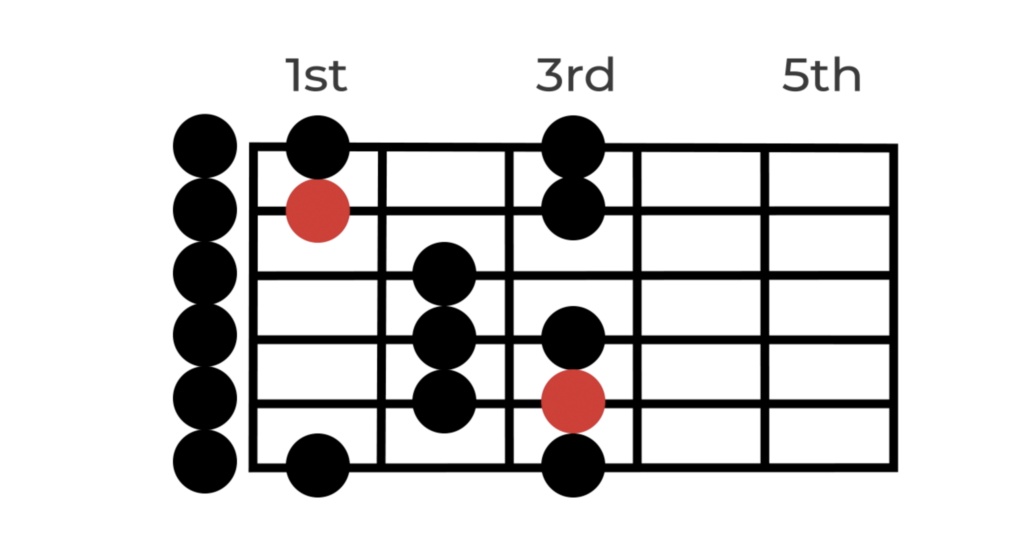
Starting from the low E we have E, F, G, A, B, C, D, E, F, G, A, B, C, D, E, F, G ascending. This gives us a range of just over two octaves to use in the first position.
If you’re new to the scale, practice playing it with a metronome using both alternate picking and all downstrokes. Make sure you get completely comfortable with the scale pattern before moving on through the course.
Chords of C major
For every degree of the scale, we can build a chord. We do this by stacking diatonic 3rd intervals, check out the article building chords. By doing this we get the chords C, Dm, Em, F, G, Am, Bdim, by going the extra step and adding another note (stacking on another 3rd) to the chord, we get all the 7th chords in C major: Cmaj7, Dm7, Em7, Fmaj7, G7, Am7, and Bdim7. The following diagrams show all the triad chords and all their 7th versions. When learning the arrangements in this series we will use both triads and 7th chords.
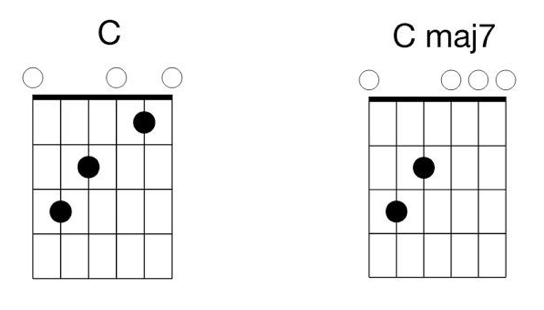
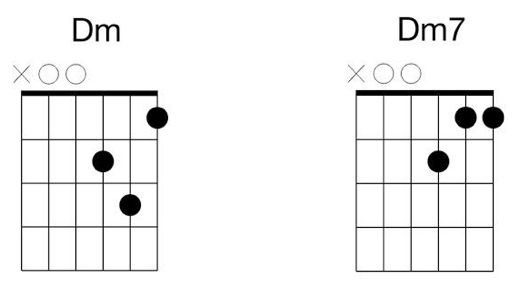
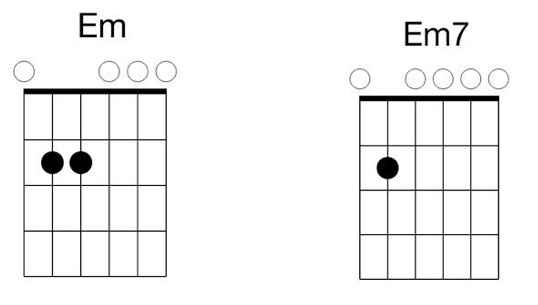
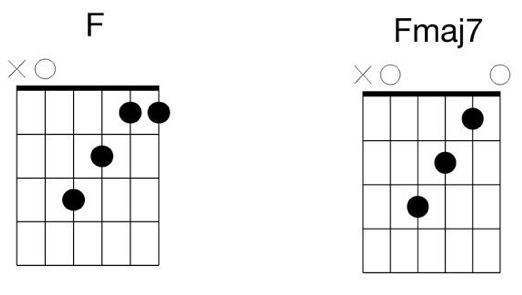
Practice changing between these chords and fretting them as quickly and cleanly as possible.
Learn with LPM
If you are looking to feel comfortable with playing basic major and minor chords, power chords, and apply different strumming techniques to your practices with Ze, check out his course called Rhythm Guitar
Melodic movement within chords
Before we move into the next lesson, practice alternating between the triad and its 7th. For example, Em to Em7, the difference being the D string. Strum the E minor and try taking off your finger to create the Em7 whilst keeping the chord ringing, the changing note we get is E to D.
Here is an audio example of strumming the Em chord and alternating between the E (tonic) and D (7th).
Try this technique with all the chords, this will develop the motion of moving your fingering whilst keeping a chord ringing which is a vital technique in playing solo guitar.
C - Cmaj7
Dm - Dm7
Em - Em7
F - Fmajor7
G - G7
A-Am7
Bdim-Bdim7
It is vital that you focus on keeping all the notes you are not moving ringing, this can be achieved by paying close attention to your fretting hand when moving the fingers, make sure you do not lift off any unnecessary fingers or cover up any ringing strings. The chord will be our accompaniment and the individual notes will be our melody. The next step will be to start playing the scale around the chords. This means to hold a chord and play as many notes of the scale as physically possible while still holding the chord.
To be Continued...
From this article, we have learned the scale and all the relevant chords, nothing beyond these will be used in the course, we will be learning how to combine the two and play guitar accompanying ourselves.
More About the Teacher
Rowan Pattison is an Australian jazz and contemporary guitarist. His resumé boasts artists such as American singer Bobby Arvon (Happy Days), Broadway star Michelle Murlin, American Idol finalist Lou Gazzara, Marcus Terrel from America’s Got Talent, Vegas Trumpet prodigy Greg Bohnam and American Comedian James Stevens III, who is featured regularly on The Tonight Show and Comedy Central. Now based in Melbourne, Rowan has just lead his own trio concert Impressionism of Bill Evans on a tour of Europe playing concerts in Kyiv, Lviv, Krakow and Paris. Rowan's guitar courses with Liberty Park Music include the Introduction to Jazz Improvisation and Introduction to Solo Guitar.

